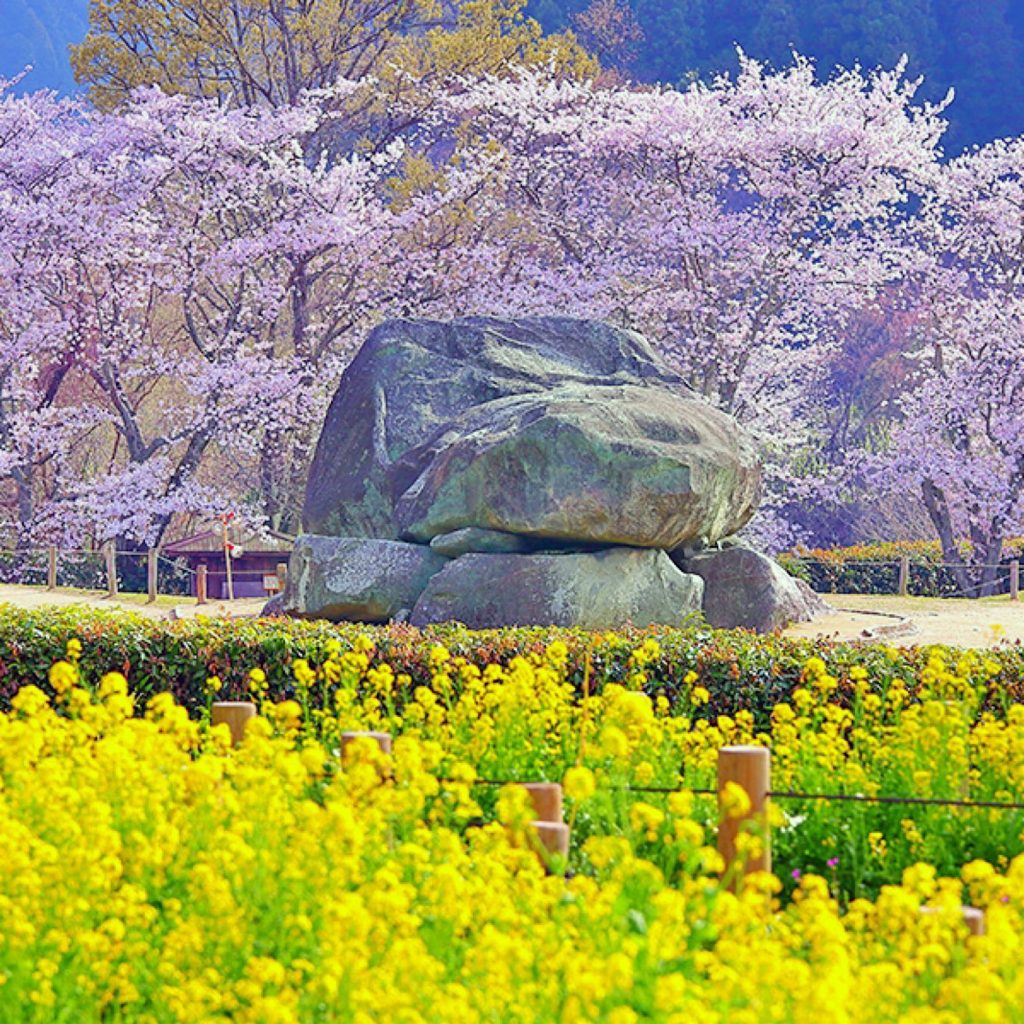
The giant Ishibutai Kofun located in Asuka Village, Nara Prefecture. Currently, it is surrounded by blooming cherry blossoms and rapeseed flowers. Throughout the seasons, many visitors come here, and the surrounding area is a grassy square. In spring, the beauty of peach and cherry blossoms, and in autumn, the blooming cluster amaryllis, along with the enjoyment of dreaming about ancient times, swell the heart. The length of the stone chamber is 19.1 meters, the main chamber is about 4.7 meters high, 3.5 meters wide, and about 7.6 meters deep. The total weight of the stones is estimated to be 2,300 tons. The largest stone in the tomb, the ceiling stone, weighs approximately 77 tons on the south side and about 64 tons on the north side, making it a gigantic ancient tomb. It is estimated to have been built around the beginning of the 7th century, but the identity of whose tomb this huge tumulus is remains unknown. A prevailing theory suggests it might be the tomb of Soga no Umako, who was powerful in the latter half of the 6th century. However, there is no solid evidence for this. Recent studies even propose the theory that Soga no Umako and Prince Shotoku might be the same person. The late 6th and early 7th centuries were a turning point in Japanese history. Fujiwara no Kamatari, son of Kamatari, who was granted the Fujiwara surname during the Taika Reforms, played a significant role. He was involved in the compilation of the Taihō Code, the Nihon Shoki, and the Kojiki, laying the foundation for the central power of the Fujiwara clan in Japan’s history. The history of Japan before the 7th century can be said to have been largely fabricated by Fujiwara no Fuhito. Whether this was fortunate or unfortunate, it allows for great imagination surrounding the Ishibutai Kofun.
奈良県明日香村にある巨大な石舞台古墳。いま周りはサクラとナノハナが咲き乱れています。春夏秋冬ここを訪れる人は多く、周囲は芝生広場になっていて、春は桃やサクラ、秋は彼岸花が咲く景色の美しさとともに、古代に夢を馳せる楽しさで胸が膨らみます。石室の長さは19.1m、玄室は高さ約4.7m、幅約3.5m、奥行き約7.6m、石の総重量は推定2,300t、古墳最大の巨岩である天井石は、南側が約77t、北側約64tもあるという巨大古墳。築造は7世紀初め頃と推定されていますが、この巨大古墳が誰の墓なのかはいまだに特定されていません。6世紀後半に権勢を誇った蘇我馬子の墓ではないかとの説が有力です。しかしこれとて確たる証拠があるわけではありません。最近の研究では、蘇我馬子と聖徳太子は同一人物ではないかという学説も出るほどです。7世紀前後は日本の歴史の分岐点で、大化の改新で藤原の姓を下賜された鎌足の息子であり、大宝律令や日本書紀、古事記の編纂に関わり、その後の中心勢力「藤原」の礎になった藤原不比等が日本歴史を大きく改ざんしました。7世紀以前の日本の歴史はこの不比等がでっち上げたといっても過言ではありません。それが幸いしたのか災いしたのか、この石舞台古墳にも大きく想像力を膨らませることができるのです。
